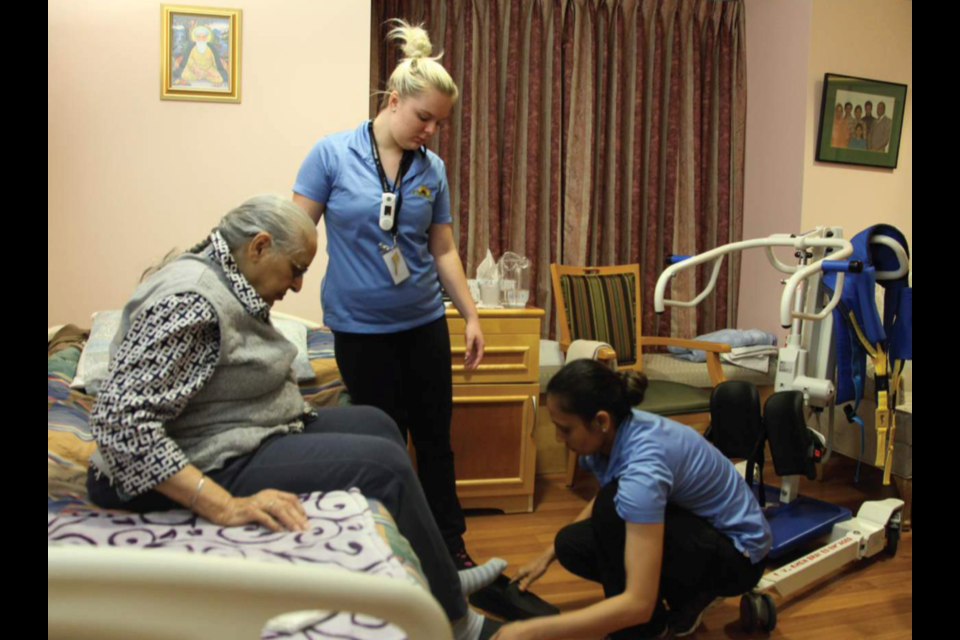A study released by the BC Care Providers Association (BCCPA) warns British Columbia’s healthcare system will struggle to cope with long-term care as the baby boomer generations grows and the Tri-Cities won’t be immune from the silver tsunami.
The report, released last week, says data extrapolated from the provincial health ministry’s growth forecasts demand for long-term care will spike in the next two decades. The organization, which represents private and non-profit operated long-term care facilities, projects the province will need up to 45,000 new long-term care beds by 2041. Currently there’s a shortage of 3,000 beds, said the report.
The 12 recommendations made in the report, titled Bedlam in BC’s Continuing Care Sector, include having the province explore new care models, developing regional initiatives, and expanding home care and assisted living.
The report notes the provincial government has plans on the books for only one new facility across the province. Daniel Fontaine, CEO of BCCPA which represents private and not-profit run facilities and organizations, said there will be greater pressure put on hospitals as the population ages.
“When people need that care the backstop is the hospital and so [elderly Tri-Cities residents with health issues] might typically end up at Royal Columbian [in New Westminster] or others in the area,” said Fontaine in an interview with The Tri-Cities News, noting hospitals in the area are already overcrowded. “And beds there [RCH] cost $1,800 a day.”
 In a BCCPA press release Fontaine said, “The gap between available beds and those who need them will continue to widen unless there are substantial investments in the number of long-term care spaces. We have had decades to plan for this, so why are we still just catching up?”
In a BCCPA press release Fontaine said, “The gap between available beds and those who need them will continue to widen unless there are substantial investments in the number of long-term care spaces. We have had decades to plan for this, so why are we still just catching up?”
Although he didn’t have specific figures, Fontaine said told The News the Tri-Cities doesn’t appear to be an outlier one way or another in the demand for long-term care. That would mean if BCCPA’s projections are correct the Tri-Cities would need approximately another 2,500 beds by 2041.
Statistics Canada census figures from 2016 showed Coquitlam, Port Coquitlam and Port Moody had 30,930 residents aged 65 and older, including 3,345 who were at least 85 years of age. The stats also show there were many more on the way to senior citizenry with 32,155 between 55 and 64.
The BCCPA report, written by director of research Michael Kary, said as of March 2018, there were approximately 1,400 people in B.C. waiting for admission into long-term care. That’s a 7% increase over the previous year.
Fontaine said some facilities operate without government funding charging residents in the range of $5,000 and $7,000 a month. But that market is limited and for enough beds and service to be provided government participation is required.
“It’s been a long-standing partnership between the government and the providers. That model has worked incredibly well,” said Fontaine, who hopes the report will provide an impetus for all the key players to get together to come up with a plan for the future.
One of the report’s charts indicates only 22% of those seeking long-term care space in the Fraser Health region, which includes the Tri-Cities, received their first choice of facility in 2017/18 compared to 31% three years earlier (2014/15). Provincially it went from 37% in 2014/15 to 31% in 2017/18.
The report said B.C. care homes have approximately 42,000 residents with an average age of 85, many with dementia (61.4%), diabetes (20.2%) and cancer (6.7%) with almost a third having severe cognitive impairment. Although frail seniors in long term care make up only 15% of the population, they use about 21% of health system bucks and are a major cost driver, noted the report. It also pointed out the C.D. Howe Institute estimates the cost of long-term care is going to leap from $69 billion in 2014 to $188 billion by 2050 in inflation-adjusted dollars.
The full report is available at bccare.ca.



